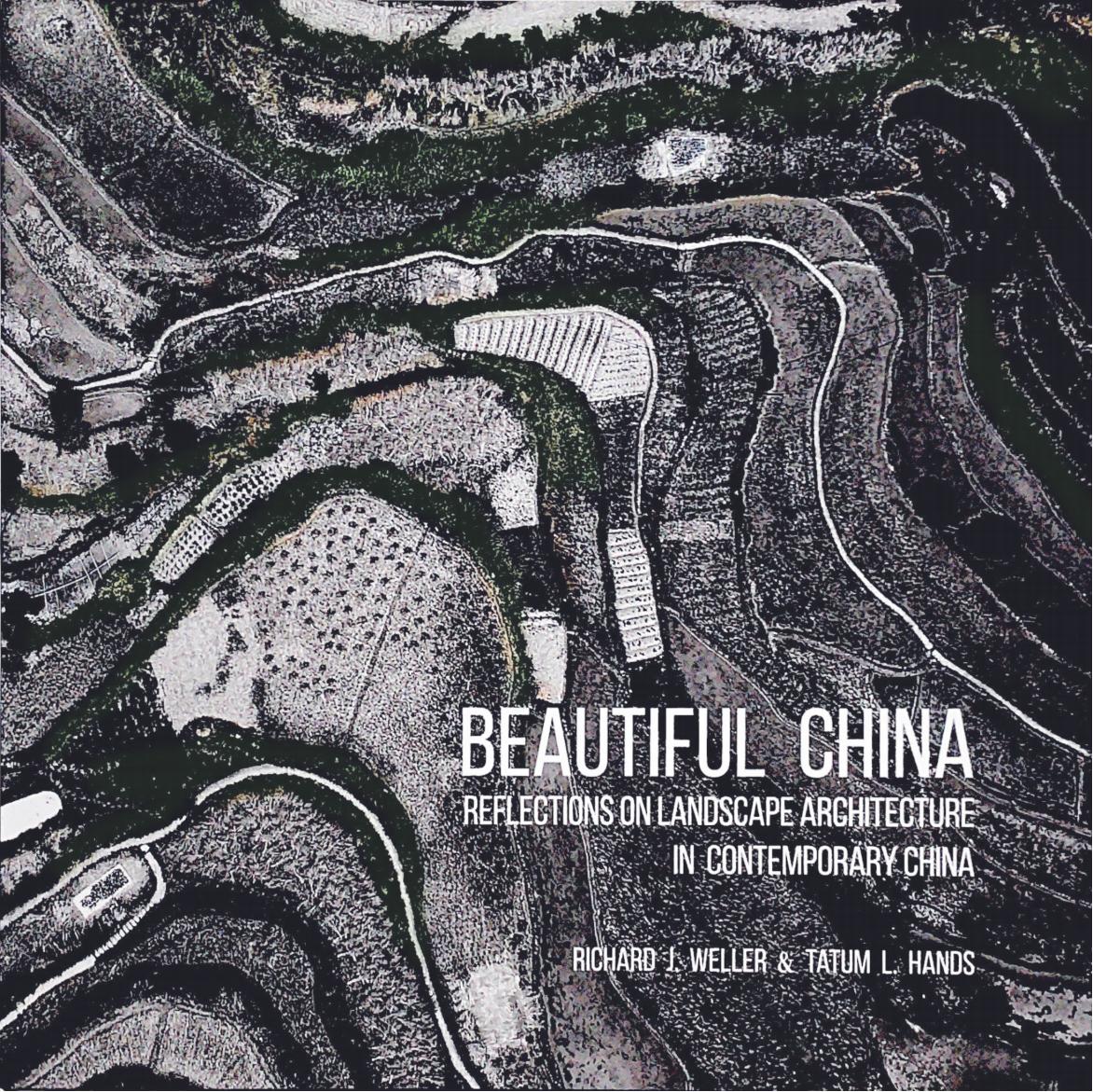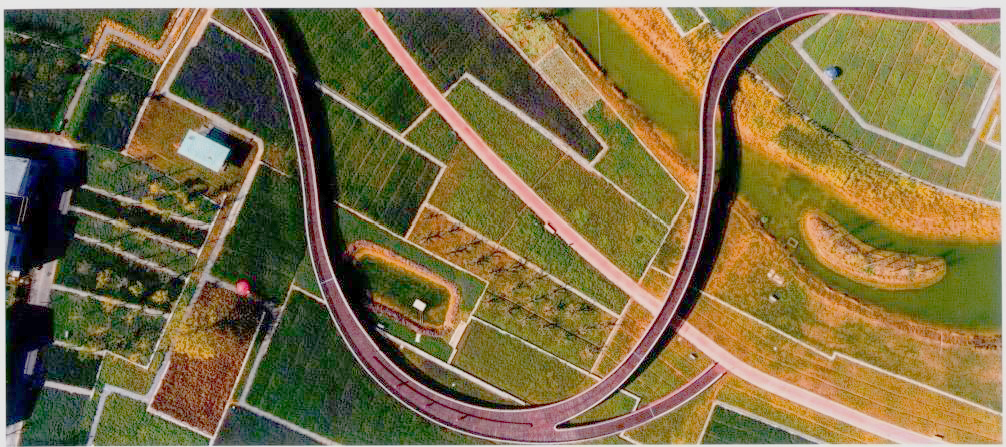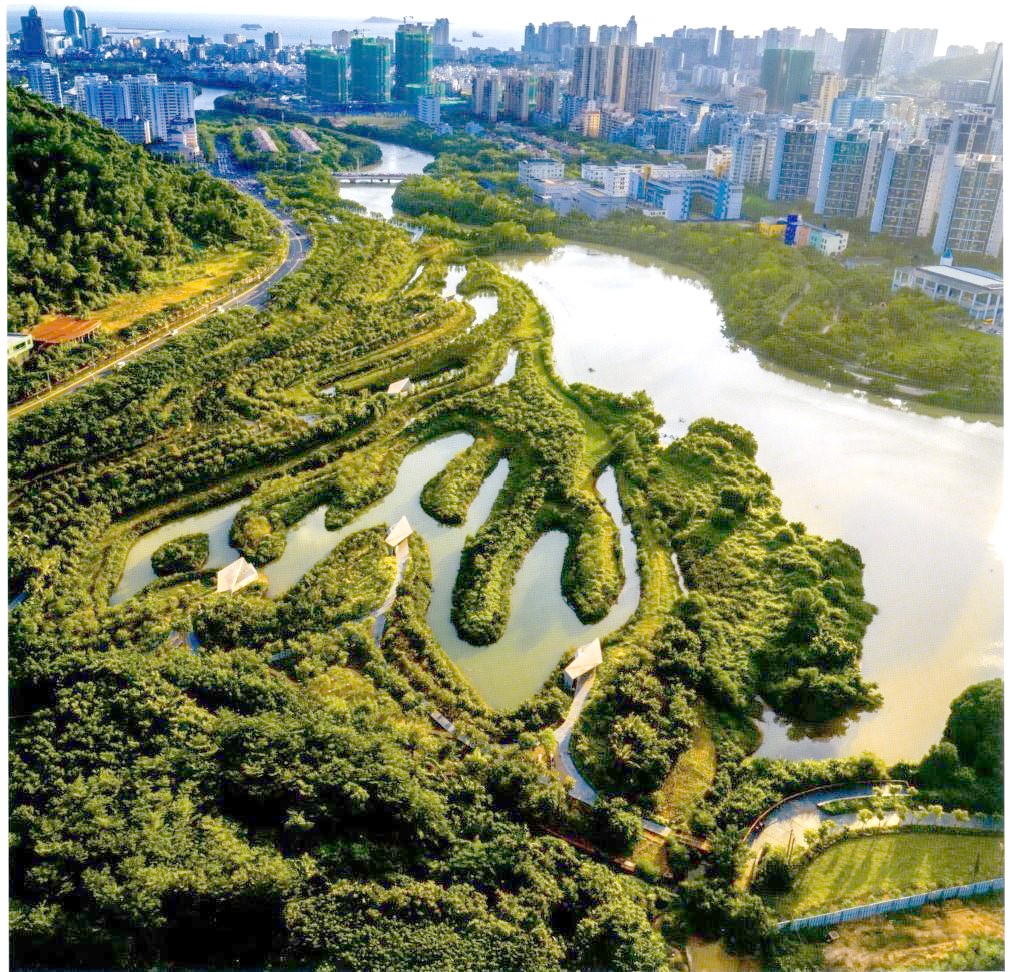Beautiful China and the Mission of Landscape Architecture
- 摘要:
- “美丽中国”是 一 个充满魔力的概念,是 一 个理 想社会及其存在空间的形态。作为 一 个14亿人民奋斗 的“中国梦”,其完整的诠释应该回到2012年11月8日, 中国共产党第十八次全国代表大会的报告:“建设生态 文明,是关系人民福祉、关乎民族未来的长远大计。面 对资源约束趋紧、环境污染严重、生态系统退化的严峻 形势,必须树立尊重自然、顺应自然、保护自然的生态 文明理念,把生态文明建设放在突出地位,融入经济建 设、政治建设、文化建设、社会建设各方面和全过程,努 力建设美丽中国,实现中华民族永续发展。”Beautiful China is a concept full of magie: it depicts an ideal society and its environment. As a "Chinese Dream" that 1.4 billion people are now pursuing, it dates back to the report of the 18th National Congress of the Communist Party of China on November 8,2012
文章来源:Kongjian Yu. (2020). Beautiful China and the Mission of Landscape Architecture. In: R. J. Weller & T. L. Hands (Eds.), Beautiful China: Reflections on Landscape Architecture in Contemporary China. Novato: ORO Editions, pp. 22-29

“美丽中国”是一个充满魔力的概念,是一个理想社会及其存在空间的形态。作为一个14亿人民奋斗的“中国梦”,其完整的诠释应该回到2012年11月8日,中国共产党第十八次全国代表大会的报告:“建设生态文明,是关系人民福祉、关乎民族未来的长远大计。面对资源约束趋紧、环境污染严重、生态系统退化的严峻形势,必须树立尊重自然、顺应自然、保护自然的生态文明理念,把生态文明建设放在突出地位,融入经济建设、政治建设、文化建设、社会建设各方面和全过程,努力建设美丽中国,实现中华民族永续发展。”

非常有意思的是,这个由中国共产党提出来、作为社会主义中国建设目标的伟大理想,今天却由美国的大学机构,宾夕法尼亚大学设计学院来主持讨论!这样的讨论充满挑战却极其令人振奋。发起人在其对外发布的公告说:”“其目的是为世界景观设计学的讨论以及在全球背景下讨论中国的景观设计学,尤其是服务于美丽中国建设的景观设计学建立一个平台。”从这个意义上说,这确是一个非常有意义和值得深入探讨的课题,它需要我们明确设计学科、特别是景观学与美丽中国的关系,在具体的操作性层面上认识它、理解它,并使我们的学术和实践能为之服务。具体的说,我们必须明确三个方面的问题:美丽中国是什么,它与国土空间和景观有何关系?什么样的中国是美丽的,其评价标准是什么?如何来实现美丽中国,景观学的途径是什么?
首先, 美丽中国是美好的社会形态及其在大地上的投影。从原始出处中,我们所以看到,美丽中国实质是一种理想社会形态的描绘,可以表述为经济繁荣、政治清明、文化昌盛、社会公平和谐的理想社会形态。显然,这个意义上的美丽中国远远超出了景观学的研究范畴。景观学关心的是物质空间上的美丽中国。所幸的是,景观学的理论告诉我们,物质的景观形态恰恰是社会形态的投影和折射(1)。当然,反过来,美丽的景观影响人们的行为乃至社会形态,即所谓一方水土养一方人,穷山恶水出刁民。战乱频繁、贫富不均、不讲法治的社会,必然是遍地高墙深壑,鸟兽绝迹;一个贪腐泛滥,暴民横行,是非不分,黑白颠倒的社会,必然污水横流,垃圾遍地。有了清明和谐的社会,便会有绿水青山之大地。反之也然,桃花源的美丽,孕育了桃花源中人的夜不闭户、怡然自得的社会形态。从这个意义上说,营造美丽中国,景观设计学当仁不让。
第二,什么样的中国是美丽的,其评价标准是什么?这恰恰是美丽中国建设能否成功的关键。君不见,遍中国大地的丑陋景观,都是在“美丽”的名义下规划设计和实施出来的,诸如城市中畸形怪状的建筑,令人啼笑皆非的巨型广场和霓虹灯闪烁的“景观大道”,绵延几十公里甚至几百公里的渠化、硬化的河流,偏僻乡村的汉白玉河道和“金水桥”、“天安门”,城市种满大街从乡下移栽来的奇花异木、古树名木和太湖石,节庆广场上的龙形和凤形花坛,等等,不一而足。在美化的名义下,我们毁掉了大地的生态与自然之美,乡村的质朴与丰产之美,城市的文化与生活之美。所以,有了美丽中国建设的号角,我们尚需要有一个关于美的标准的顶层设计,也就是需要有一个主流的审美价值体系,来引导美丽中国建设的实践。中国几千年的封建主流文化中,就有近2000年的以“小脚”为美的士大夫主流审美观,因此,遍中国良家妇女皆以裹足为美。畸形和病态的小脚被作为高雅与美的标准,病态之美因此而泛滥牺牲健康、不事生产、残缺畸形、表里不一、无病呻吟、扭捏作态。这种审美观注定是不可持续的!因此,必须回归健康、寻常的“大脚之美,”它将还疾病缠身的中国城乡以生机勃勃的健康之美、生态之美、丰产之美、乡土而朴实之美。这样的“大脚之美,”正是中国最高决策层所提出的生态文明建设理念的美丽中国,是一种“深邃之形”,一种将人类的欲望建立在生态和可持续理念之上的美。
这种大脚之美的核心是关于自然所提供的生态系统服务(ecosystem Services)是人类福祉的来源的认识论和价值观。人民对美好生活的向往,本质上是高品质的生态系统服务,包括供给服务、生命承载、调节服务和精神文化服务。它们是人与自然之间和谐关系的纽带,也是“绿水青山就是金山银山”(习近平语)的根本逻辑所在。这一逻辑确立了“人对美好生活的向往---美丽中国---高品质的生态系统服务---安全和健康的国土生态系统(景观)” 之间的统一关系。所以,美丽中国的标准就是高品质的生态系统服务,而高品质的生态系统服务有赖于能持续提供这些服务的自然之“大脚”——在国土空间有限条件下、对维护生态过程具有关键意义的生态安全格局和以生态安全格局为核心的生态基础设施。而这正是中国景观学将可以大显身手的地方。

第三,如何来实现美丽中国,美丽中国的景观学途径是什么?
因此,规划和设计美丽中国的“深邃之形”——具有高品质的生态服务、人与自然和谐共生的景观,是景观学在美丽中国建设中的首要、也是核心的任务。而景观学的本质是人类改造自然、协调人与自然关系的学问。从发生学的角度来说,人与自然的关系都是由于人的出现,改变了自然原有的生态系统。这种改变或是和谐的,或是冲突的,和谐或冲突的程度一方面取决于人类对自然改变或干扰的强度,另一方面也取决于自然生态系统本身的韧性。由此,我们来定义生态文明理念下的美丽及其形态:建立在自然生态系统的韧性基础上的人类改造自然的活动及其创造的形态。也就是说,美丽中国是与自然相适应的中国人改造世界的活动及其创造的物质和社会形态。这就回到了“劳动创造了人”和“劳动创造美”这一命题。正是人类为生存而进行的改造自然、改造社会的劳动,才是人类得以进化的根本动力,也是推动人类社会进步的根本动力。从这个意义上来说,美丽中国便是中国人民的“生存的艺术。”(2)
从人类改造自然而创造美丽的角度出发,也就是景观学的角度,生态文明理念下的美丽中国的形态需要从三个层面来营造:美丽的构形(Configurative Form)、美丽的变形(Transformative Form)及美丽的行为本身(Behavior)。这三者构成了美丽的深邃之形(3)。
美丽的构型(Configurative Beautiful Form):人与自然的空间毗邻关系而形成的格局。由于人的活动的介入使自然的空间格局发生改变,这种改变首先体现在人与自然的空间关系上,即人与自然之间必须划出一条界限,来表征两者的空间关系。人与自然相互作用的人类生态系统是多尺度的,从一个家园、到城市、区域和整个国土,通过跨尺度的自然保护空间的划定,保障自然生态系统结构和过程的完整性和连续性。如河流廊道的边界,自然保护区的边界,明确人类活动与自然之间的分界线,通过这条边界(生态红线、底线等)的划定,确定了人与自然关系的空间格局。美丽的格局就是人与自然的界限是否划得合理,是否各自都有空间,两者的碰撞是否具有韧性和余地。

美丽的变形(Transformative Beautiful Form):景观的第二种形态体现在人与自然之间的第二种关系中,即两者在空间上的叠加关系,或是融合的关系。在许多情况下,人类活动和自然之间没法划定明确的边界。如梯田是人类文化的产物,但它是离不开自然基底和自然过程而存在的,它是文化与自然的叠加而产生的形状。在生态文明的理念下,这种形状是否美丽,取决于人类的文化活动是否适应于自然的地形、水文、营养流和物种的生长规律。也就是人类的改造活动是否与自然过程相适应。在这里,人与自然和谐的形状,也就是美丽的形状就如纸张下的硬币在铅笔涂抹后留在纸上的图案。
美丽的行为(Beautiful Behavior)是指与资源诉求相关联的人类生产生活方式。尽管这方面并不是物质空间的规划设计的核心内容,但无处不体现在景观的设计、改造、使用及管理的各个方面。人类为满足自己的欲望而进行的生产生活过程,在更深层面上决定了人与自然的关系。人与自然和谐的行为方式,也就是美丽的标准,体现在通过节制欲望、提高效率和减少污染,来管理人类对资源的诉求或对环境的冲击,另一方面,也通过明智地协调人的活动与自然之间的空间格局关系以及人与自然之间的空间叠加关系来引导人类的生产生活方式和行为。
构型、变形和行为三个层面相互联系、共同作用,构成了一个完整的、景观学介入美丽中国建设的操作界面和行动路径。景观作为社会形态在大地上的投影,以及景观对人类行为和社会的反作用,注定使景观学将成为美丽中国建设的中坚。也正因为如为此,中国城市科学研究会于2017年发起成立了“景观学与美丽中国建设专业委员会,”并提出宣言:“天降大任!景观设计师具有独特的优势,使其能将相关专业联合一起,形成新的联盟来应对复杂生态和环境问题。我们坚信,只要深刻认识到地球系统的复杂性和整体性,认识到人类活动与自然系统之间需要和谐调理,通过的整体的功能协调和艺术的设计,重建美丽和谐的新桃源:从国土和区域,到城市和乡村。当前最紧迫的任务是国土生态重建、城市修补和生态修复、海绵城市建设以及广大乡村的保护和建设。” (4)。
Beautiful China is a concept full of Magic; it depicts an ideal society and its environment .As a "Chinese Dream"that 1.4 billion people are now pursuing, it dates back to the report of the 18th National Congress of the Communist Party of China on November 8,2012,which declared:"Building an ecological civilization is a matter of people's well-being and a long-term plan for the future. Facing the situation of resource constraints, environmental pollution, and degraded ecosystems, we must establish an ecological civilization that respects nature, adapts to nature,and protects nature,and puts ecological civilization construction in a prominent position and integrates it into the whole process of economic,political,cultural,and social construction so as to build a beautiful China and realize the sustainable development of the Chinese nation."
From the original source, we can see that the essence of Beautiful China is a depiction of an ideal social form,as a social form of economic which can be expressedrectitude, cultural richness, socialprosperity, political equity, and human-nature harmony. In this sense, Beautiful China obviously goes far beyond the study of landscape architecture. That said, landscape architecture is directly implicated in the realization of Beautiful China because,as Denis Cosgrove has explained,the material world is precisely the projection and refraction of social forms. In turn,the form of the landscape can also affect people's individual behavior and society's collective form.
There is a Chinese expression that different environments give different characteristics to their residents - bad environments create ugly people,beautiful mountains and waters nurture good people.A society with frequent wars, corruption,and inequality will be a place with high fences and no trace of vitality,a place with open sewers and garbage everywhere.In contrast,the utopic image of the "land of peachblossoms"(paradiseinChineseculture)invokesan equal and harmonious society,a place with vast green land and clear blue water.In this sense,landscape architecture has a central role in building a beautiful China.
We must ask then what kind of China is beautifal,and by what criteria do we measure this beauty? This is the key to achieving the successful construction of Beautiful China. Sadly, most of the ugly landscapes of Chima are designed and constructed in the name of beauty:countless odd buildings in the cities,ridiculous giant plazas,and huge boulevards blazing with neon light. Tens, or even hundreds,of thousands of kilometers of channelized river are built with lifeless hard riverbanks; marble paving and fakeTiananmenSquaresarebuiltinremotevillages:exotic ornamental plants,deformed ancient trees,and Taihu rocks are shipped thousands of miles from villages to beautify cities;and shrubs are trimmed into the shapes of dragons and phoenixes to decorate central squares
In the name of such superficial beautification,we ruin the rcal beauty of the ccosystem and the nature of our land, the beauty of the countryside's simplicity, authenticity, and richness, and the beauty of the city's cultural life. Therefore, along with the call for the creation of Beautiful China,we also need a top-down specification of the criteria of beauty;which is to say, we need a mainstream aesthetic value system to guide the construction of Beautiful China.For example, for two thousand years in China there has been an acsthetic of admiring females'"small feet." In pursuit of this gentrification,women from all over China had their feet bound,sacrificing their health and their ability to work. This acsthetic is destined not to last. We must return to the healthy and ordinary aesthetic of "the big feet,"which will restore the beauty of health,the beauty of nature,and the beauty of fertility,and return authenticity to the Chinese countryside and citics that are "ugly-ridden."The beauty of the healthy big feet is precisely the beauty of Beautiful China and the beauty of ecological civilization that has been proposed by China's leaders. It is a beauty with depth, a beauty which infuses human desire with the concepts of ecology and sustainability.
As President Xi Jinping has said "clear waters and green mountains are as good as mountains of gold and silver."This logic establishes the unity of the desires for a better life,for a beautiful China,and for a safe and healthy environment.These desires depend upon the existence of high-quality ecosystem services, which in turn depend upon China securing the ecological integrity of its landscapes. And this is also the stage where Chinese landscape architecture can show its talents.
This leads to the question, how can landscape architects best help achieve Beautiful China?Planning and designing the landscape with high-quality ecological services must work with the deep form of the landscape and strive to creale a harmonious coexistence between humanity and nature. This is the primary task of landscape architecture in the construction of Beautiful China.The essence of landscape architecture lies in knowledge about how humans interact with and change the natural environment.This change can be either harmonious or conflicting,and the degree of harmony or conflict depends on the extent of humanity's disturbance of natural ecosystems. On the other hand, it also depends on the resilience of the natural ecosystem itself.From this understanding,we can define the beauty and form of the concept of ecological civilization as the sum total of the activities of human transformation of the land that are based on the resilience of natural ecosystems. In other words,Beautiful Chima is an activity that transforms the world through adaption of nature. It is the material and social forms of this activity. This meaning returns to the manifesto of Marxism that "labor creates people"and "labor creates beauty," the labor of transforming nature and society for human survival is the fundamental driving force for human evolution and the advancement of human socicty. In this sense, Beautiful China is the "art of survival" of the Chinese people.2
The form of Beautiful China under the overarching concept of ecological civilization needs to be created on three levels configurative beautiful form,transformative beautiful form, and beautiful behavior.These throe together constitute what I refer to as beautiful deep form.'
Configurative beautiful form is a pattern depicting the boundary drawn between humanity and nature to characterize the spatial relationship between the two,it is the main task of spatial planning of our national land.The ecosystem in which humans interact with nature must be considered at multiple scales—home,city,region,nation—through the delineation of natural conservation spaces to ensure the integrity and contimuity of natural ecosystem structures and ecological processes.For example,through the delineation of boundaries between human activities and nature—such as the boundary of a river corridor or the boundary of a nature reserve—the spatial pattern of the relationship between humanity and nature is determined. The pattern's beauty is determined by whether the boundary between humanity and mature is reasonable,and whether there is resilient and adaptive space where they directly interact with each other.
Transformative beautiful form arises where humanity and mature are superimposed in space and time so that a new hybrid emerges.In these cases,there is no clear boundary between human activities and nature. For example, an agricultural terrace is a product of human culture,but it cannot exist without its natural base and natural processes. It is formed by the superimposition of culture and nature. With the concept of ecological civilization,whether this form is beautiful depends on the degree to which the original natural form and integrity of ccological processes are respected and included in the transformative design.In this sense,the form of harmony and beauty between humanity and nature is like the pattern of coins left on the paper after a pencil is applied on top.
Beautiful behavior, the third dimension of beautiful deep form, refers to the human use of natural resources for survival. Although this aspect is not the core content of the planning and design of material space,it is ubiquitous in all aspects of landscape design,transformation,use,and management. The production and living processes that human beings carry out to satisfy their own desires determines the relationship between humanity and nature at a deeper level. The harmony between humans and nature—that is,the standard of beauty—is reflected in managing human desires for resources or their impact on the environment by controlling desires,improving efficiency,and reducing pollution.
These three levels of configuration,transformation,and behavior interact and work together to form a complete operational interface for landscape architecture studies to engage with the construction of Beautiful China. As the projection of the social form on the land,landscape architecture is destined to become the backbone of the construction of Beautiful China.
As a conclusion, I would like to quote the manifesto declared by the Landscape Architecture and Beautiful China Committee of the Chinese Society for Urban Studies upon its establishment in 2017:
“There is a great responsibility for landscape architecture! Landscape architects have a unique advantage in coordinating all the relevant professions to form new alliances to deal with current complex ecological and environmental issues. We firmly believe that, as long as we are deeply aware of the complexity and integrity of the Earth system, and recognize the need for harmonious coordination between human activities and natural systems,with holistic functional coordination and artistic design,we can rebuild a beautiful and harmonious new land of peach blossoms ranging from the nation,the region,the cities,to the countryside.”
Reference:
1.Cosgrove D., Social Formation and Symbolic Landscape (Wisconsin: University of Wisconsin Press,1998).
2.Yu K.,The Art of Survival:Positioning Landscape Architecture (China Architecture & Building Press,2006).
3.Yu K.,"Creating Deep Forms in Urban Nature:The peasant's approach to urban design,"in Steiner,F.R.,Thompson G.F.&Carbonell A.(eds),Nature and Cities-The Ecological Imperative in □ Urban Design and Plaming (Lincoln Institute of Land Policy, 2016),95-117.
4.Landscape Architecture and Beautiful China Committee,Chinese Society for Urban Studies,"Declaration of Landscape Architecture in China”(2017).
